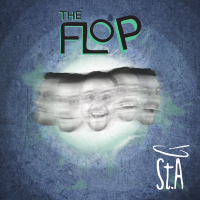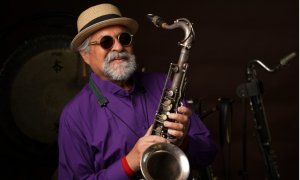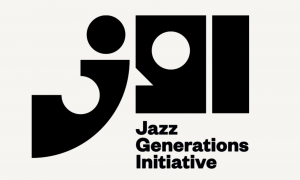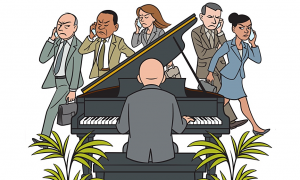
Prior to the 1969 release of pianist Les McCann's hit live album Swiss Movement, I was never much of a fan. In the 1960s, on studio LPs, he seemed a melange of pianists I liked better, including Red Garland, Gene Harris and Billy Taylor. The percussive, soul-jazz approach he favored seemed better articulated in the hands of the Cannonball Adderley Quintet. For me, McCann always sounded more dynamic live. In performance recordings, he came across as freer and spiritually present, mixing jazz, gospel and blues, and his intensity seemed to feed off responsive audiences.
Never has this been clearer than on the new release Les McCann: Never a Dull Moment! Live from Coast to Coast, 1966-1967 (Resonance). Co-produced by Zev Feldman and George Klabin, with sound restoration by George Klabin and Fran Gala and vinyl mastering by Bernie Grundman, the album is relentlessly alive, with McCann exhibiting sterling taste and an elegant intensity. The three-LP set will be released in record stores on Friday, November 24 (Record Store Day), while digital formats will be out on December 1.
Thirteen of the album's 21 previously unreleased tracks were recorded live in 1966 at Seattle's Penthouse club. The balance were captured at New York's Village Vanguard in 1967. On the Penthouse dates, McCann was joined by Stanley Gilbert on bass and Tony Bazley on drums. On the Vanguard tracks, McCann was working with bassist Leroy Vinnegar and drummer Frank Severino.
The only drawbacks for me are McCann's intros, which in places tend to drag on too long, and the surprisingly slow tempo of a number of songs you'd expect to swing. These include Sunny (it plods along for more than four minutes before picking up ever so slightly), There Will Never Be Another You and Going Out of My Head.
These quibbles notwithstanding, the first half of the album is sublime and the second half is just a little less so, but only a pinch. Overall, the material shows off McCann's stirring, soul-jazz feel and a brazen willingness to try different approaches on familiar songs. What's more, the album's live fidelity is stunningly warm and lavish, and the music is never dull, even when slower than one would like. [Photo above of Les McCann with Stanley Gilbert and Paul Humphrey, courtesy of Resonance Records and Alan Abrahams]
In the 1970s, McCann would move on to a second phase of his career, exploring a range of electric keyboards, most notably the Fender Rhodes electric piano. Tenor saxophonist Eddie Harris would join him on several of them. He also would show off his terrific singing voice. As for the 1960s, this new set showcases McCann at his creative best and may well be his best live recordings of the decade, prior to Swiss Movement in 1969.
Never has this been clearer than on the new release Les McCann: Never a Dull Moment! Live from Coast to Coast, 1966-1967 (Resonance). Co-produced by Zev Feldman and George Klabin, with sound restoration by George Klabin and Fran Gala and vinyl mastering by Bernie Grundman, the album is relentlessly alive, with McCann exhibiting sterling taste and an elegant intensity. The three-LP set will be released in record stores on Friday, November 24 (Record Store Day), while digital formats will be out on December 1.
Thirteen of the album's 21 previously unreleased tracks were recorded live in 1966 at Seattle's Penthouse club. The balance were captured at New York's Village Vanguard in 1967. On the Penthouse dates, McCann was joined by Stanley Gilbert on bass and Tony Bazley on drums. On the Vanguard tracks, McCann was working with bassist Leroy Vinnegar and drummer Frank Severino.
The only drawbacks for me are McCann's intros, which in places tend to drag on too long, and the surprisingly slow tempo of a number of songs you'd expect to swing. These include Sunny (it plods along for more than four minutes before picking up ever so slightly), There Will Never Be Another You and Going Out of My Head.
These quibbles notwithstanding, the first half of the album is sublime and the second half is just a little less so, but only a pinch. Overall, the material shows off McCann's stirring, soul-jazz feel and a brazen willingness to try different approaches on familiar songs. What's more, the album's live fidelity is stunningly warm and lavish, and the music is never dull, even when slower than one would like. [Photo above of Les McCann with Stanley Gilbert and Paul Humphrey, courtesy of Resonance Records and Alan Abrahams]
In the 1970s, McCann would move on to a second phase of his career, exploring a range of electric keyboards, most notably the Fender Rhodes electric piano. Tenor saxophonist Eddie Harris would join him on several of them. He also would show off his terrific singing voice. As for the 1960s, this new set showcases McCann at his creative best and may well be his best live recordings of the decade, prior to Swiss Movement in 1969.
This story appears courtesy of JazzWax by Marc Myers.
Copyright © 2025. All rights reserved.




























